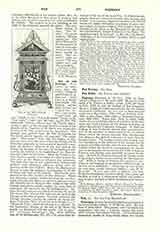

Pazmany, PETER, famous Hungarian ecclesiastic of the seventeenth century; d. March 19, 1637. He was born of noble blood. His parents were Calvinists; his stepmother, who was a Catholic, turned the boy’s spirit towards the Catholic Church. After making his elementary studies in Nagyvdrad, where two Jesuits exercised great influence over him, he went to the Jesuit college in Kolozsvar. At the age of thirteen he became a Catholic, and at seventeen entered the Jesuit novitiate. Proceeding to Rome for his higher studies, he studied for four years under Bellarmine. Afterwards he taught philosophy and theology in Gratz, and in 1601 returned to Hungary. He successively became Provost of Turoc, Bishop of Nyitra, in 1616 Archbishop of Esztergom, and lastly Cardinal Primate of all Hungary. Pazmany engaged in a literary warfare with Stephen Magyary, a Protestant preacher, who in a book entitled “The causes of the country’s ruin” (Az orszagokban val6 sok romlasoknak okairol), published in 1602, declared the Catholic religion to be the principal cause. Pazmany answered him in a work entitled “Reply to Stephen Magyary” (Felelet Magyary Istvfinnak), proving that the Protestant religion, and not the Catholic, was the cause. He translated the “Imitation of Christ” and also compiled a prayerbook, still in popular use. In 1605 appeared “Ten arguments proving the falsity of the present science”; in 1609, “Five famous letters to Peter Alvinczy”; in 1613 his great theological and apologetical work, “Hodoegus, or Guide to God‘s truths” (Hodoegus, vagy Isteni igazsagra vezerlo, Kalauz). The first part of the last work was dogmatic, the second part polemical. With unanswerable arguments he showed the truth of the Catholic religion, whose victory in Hungary he secured by this work. Henceforth Protestantism was reduced to personal recriminations and force of arms. In 1636 he published his sermons, which became a model for the priesthood.
Pazmany belongs to the first rank of preachers, his discourses being notable for their logic, rather than beautiful words. By his writings, preaching, but especially by his personal meetings he converted about thirty noble families (e.g. the Zrinyi, Wesselenyi, Nadasdy, RAkoczy etc.). These families spent most of their money in converting the people of the lower classes, whom the Reformation had seduced from the true Faith. As archbishop, Pazmany put into effect the decrees of the Council of Trent. He introduced the Missale Romanum, and was the great apostle of the celibacy of the clergy. He also displayed great activity in founding schools, building many seminaries for the education of poor students who aspired to the priesthood, and also many elementary and high schools. In 1623 he gave 46,000 dollars toward the building in Vienna of a seminary for Hungarians (the Pazmaneum), which is today in a very flourishing condition. In 1626 he built a college in Pozsony, the direction of which he placed in the hands of the Jesuits. In 1635 he built an elementary school in the same place, and in 1627 he gave 533 dollars that Hungarian seminarians might be sent to Rome to finish their theological studies. In Nagyszombat he built a seminary and also a college for the children of impoverished nobles. In 1635 he founded the first Hungarian university for the furthering of Catholic ideals; this institution is in Budapest, and is at present (1910) attended by 5000 students. Pazmany ordered that the bishops every year, and the archbishops every four years, should hold a conference, and that the deans and pastors should take an examination every year. As a politician, Pazmany desired Hungary to be a kingdom with a Catholic ruler, and that Hungary and Austria should work together in all dealings with foreign powers, Transylvania being independent. Pazmany’s idea was that, with a Catholic Hungarian king, the country would be well protected from the Turks. It was to his earnest efforts that Ferdinand II was partially endebted for his succession to the throne. In 1622 he brought about peace between Gabriel Bethlen (ruler of Transylvania) and Ferdinand II, religious freedom being granted to the Protestants. He battled so long and nobly for Catholicism, and his efforts were crowned with such great success that we may say that he was born in Protestant, but died in Catholic, Hungary.
A. BANGHA

